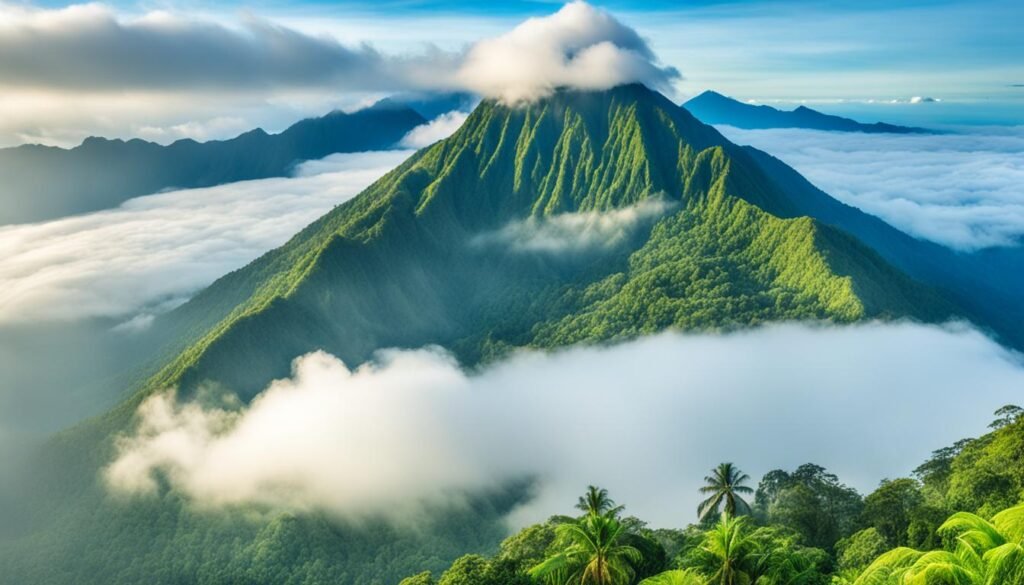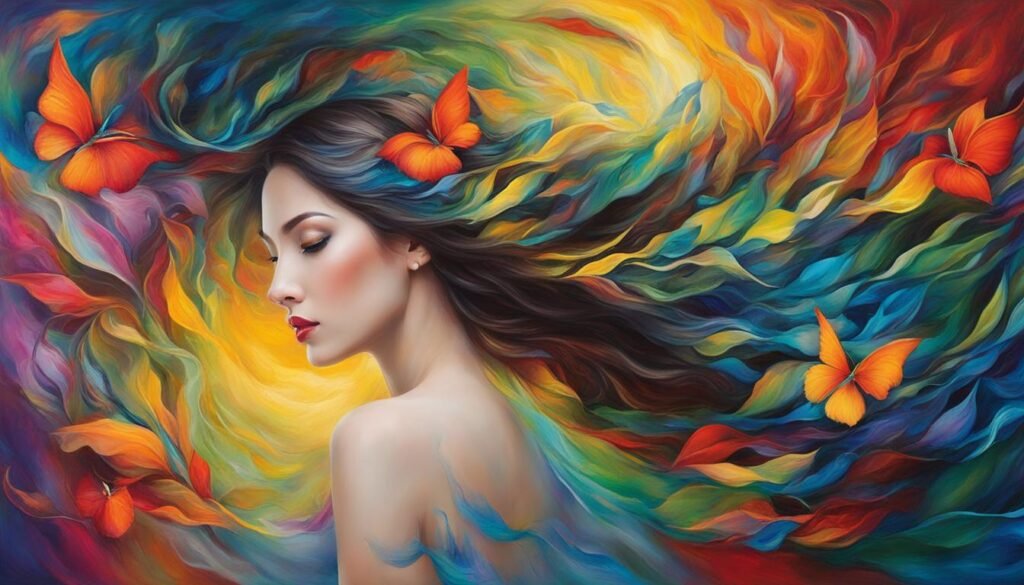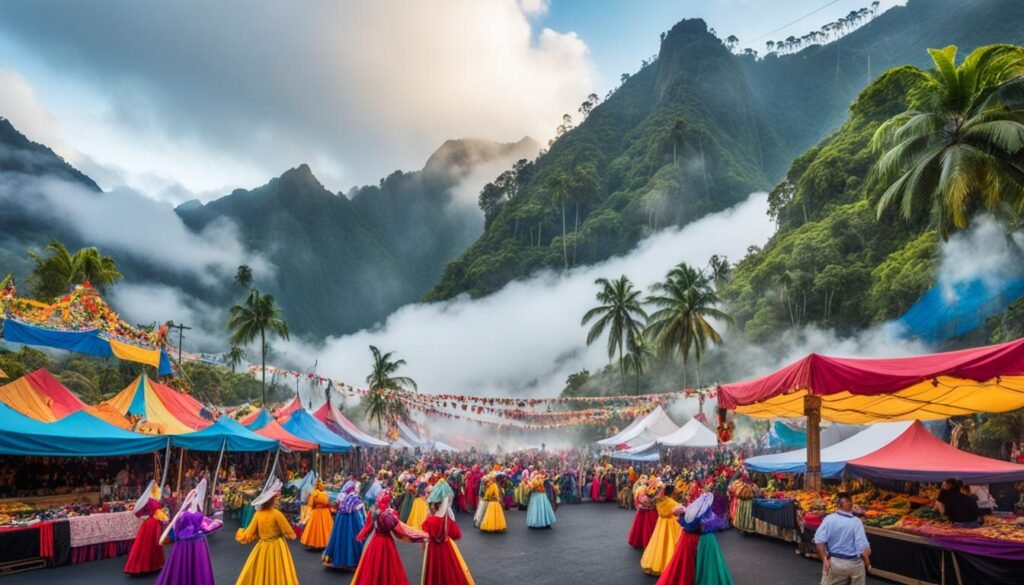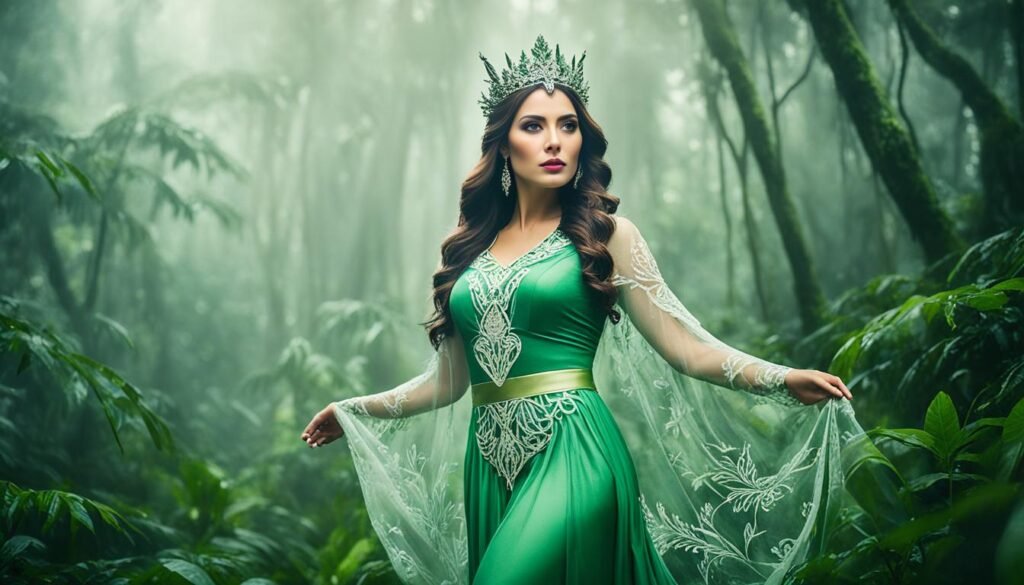In the heart of the Philippines, nestled amidst the majestic Mount Makiling, lies the mythical figure of Maria Makiling, a guardian spirit known for her beauty, grace, and connection to the natural realm.
Legend has it that Maria Makiling is the protector of the mountain and its surrounding forests. Her story has been passed down from generation to generation, captivating the imaginations of both young and old. From her mystical origins to the symbolism behind her myth, Maria Makiling has left an indelible mark on Filipino culture.
Join us on this journey as we unravel the myth and mystique of Maria Makiling, exploring her enduring cultural impact and the intersections between folklore, nature, and society.
The Enigmatic Legend of Maria Makiling
Deep within the rich tapestry of Filipino folklore lies the enigmatic legend of Maria Makiling. Known as the guardian spirit of Mount Makiling, Maria Makiling has captivated the hearts and minds of the Filipino people for generations. Her myth is steeped in mystery and intrigue, with various versions of her origin story circulating throughout the country. Some believe she was once a mortal woman, while others perceive her as a supernatural being. Regardless of her origins, Maria Makiling’s legend has become an integral part of Philippine culture, permeating art, literature, and festivals.
The Origins of Maria Makiling
Unveiling the true origins of Maria Makiling remains a challenge due to the multitude of myths and tales surrounding her birth. In one version of the legend, Maria Makiling was a beautiful woman who fell in love with a mortal man. Their love, however, was doomed, and Maria vanished into the mountains, forever guarding its treasures. Another version portrays Maria as a deity, a divine being tasked with protecting the mountain and all its inhabitants. The mystery surrounding her origins adds to her allure, heightening the sense of wonder and enchantment associated with Maria Makiling.
The Symbolism Behind Her Myth
The tale of Maria Makiling is laden with symbolism deeply rooted in nature and the environment. As the guardian spirit of Mount Makiling, she epitomizes the harmony that exists between humans and the natural world. Maria Makiling is often portrayed as a protector of the mountain’s rich flora and fauna, emphasizing the importance of preserving the environment for future generations. Her association with fertility, abundance, and the cycles of nature further highlights the significance of sustainability and the interconnectedness of all living things.
Portrait of Maria in Philippine Culture
Maria Makiling’s cultural significance extends far beyond her legend. In Philippine society, she has become a beloved figure celebrated in various forms of artistic expression. Artists and writers have depicted her beauty and grace in paintings, poems, and novels, capturing the essence of her myth and mystique. She also holds a prominent place in traditional festivals and religious ceremonies, where her presence brings a sense of reverence and awe. Additionally, Maria Makiling serves as a reminder of the deep roots and rich heritage of Filipino culture, reinforcing the country’s unique identity.
Mount Makiling: The Sacred Abode
Mount Makiling is not just a backdrop for the Maria Makiling legend; it is a sacred mountain with significant geographical features. The mountain’s unique shape and lush forests contribute to its spiritual significance for many Filipinos.

Geographically, Mount Makiling stands as a prominent landmark on the island of Luzon in the Philippines. It is an inactive stratovolcano located in the province of Laguna and is part of the larger Sierra Madre mountain range. Rising to an elevation of 1,090 meters (3,580 feet), the mountain stretches across approximately 14 kilometers (8.7 miles) of land.
The dense forests of Mount Makiling are home to a remarkable biodiversity, making it a hotspot for conservation efforts. It is recognized as an ASEAN (Association of Southeast Asian Nations) Heritage Park, highlighting its ecological importance. The mountain’s diverse ecosystem supports numerous endemic species, some of which are found nowhere else in the world.
The conservation of Mount Makiling’s biodiversity is crucial for the preservation of these unique species and overall ecosystem health. Efforts are in place to protect and manage the mountain’s natural resources, ensuring the sustainability of its rich biodiversity for future generations.
| Geographical Features | Biodiversity | Conservation |
|---|---|---|
|
|
|
Unraveling the Maria Makiling Folklore
The folklore surrounding Maria Makiling is a tapestry of captivating legends, enchanting stories, and awe-inspiring supernatural abilities. These tales depict Maria Makiling as a complex and multi-faceted mythical figure, embodying both benevolence and vengeance.
Legend has it that Maria Makiling is a devoted guardian of the environment, using her supernatural powers to protect the lush forests, rivers, and wildlife of Mount Makiling. She is often portrayed as a gentle spirit, guiding lost travelers and aiding those in need.
However, the Maria Makiling folklore also reveals her dark side. In some stories, she manifests her wrath upon those who violate the sanctity of her mountain, punishing trespassers with natural disasters or illness. This duality exemplifies the intricate nature of Maria Makiling’s character and adds to her allure.
To fully grasp the significance of Maria Makiling in Filipino society, it is essential to unravel the layers of her folklore. Each story and legend offers a glimpse into the enduring cultural impact of Maria Makiling and her supernatural abilities. From her role as an environmental protector to her embodiment of justice, Maria Makiling continues to captivate the imaginations of generations, remaining an integral part of Filipino folklore and cultural identity.
Guardian of Nature: Mariang Makiling’s Role
Maria Makiling’s influence extends far beyond the realm of folklore. Her mythical persona has inspired numerous conservation efforts across the Philippines, making her a symbol of environmental stewardship and the importance of protecting nature. From grassroots organizations to government initiatives, the legend of Maria Makiling has sparked a movement in which individuals and communities strive to preserve the natural beauty of their surroundings.

Organizations dedicated to the preservation of the environment often adopt Maria Makiling as an emblematic figure, representing the vital role of an environmental guardian. They draw inspiration from her mythical powers and her connection to the natural world, using her story to raise awareness and mobilize actions that benefit the overall conservation of the Philippines’ rich biodiversity.
Moreover, Maria Makiling holds profound significance in Filipino cultural identity. She embodies the harmonious relationship between humans and nature, symbolizing the interconnectedness and interdependence of both realms. In a country known for its deep appreciation of nature, Maria Makiling serves as a cultural touchstone, reminding Filipinos of their shared responsibility to protect and preserve the natural heritage that surrounds them.
| Conservation Initiatives | Cultural Identity |
|---|---|
|
|
The Cultural Impact of Diwatas in the Philippines
Diwatas are supernatural beings in Filipino folklore that hold significant cultural importance. These mystical creatures play a prominent role in Philippine mythology, captivating the imagination and belief systems of the Filipino people. Understanding the role of diwatas in mythology sheds light on their cultural impact and the profound influence they have on Filipino society.
Understanding Diwatas and Their Role in Mythology
Diwatas are revered as powerful and benevolent beings in Filipino folklore. They are often depicted as beautiful, ethereal creatures that inhabit the natural world, such as forests, rivers, and mountains. Diwatas are believed to possess supernatural abilities and are regarded as guardians of nature, protecting the environment and its resources.
These mythical beings symbolize the deep connection between humans and the natural world. The respect and reverence bestowed upon diwatas reflect the Filipino people’s cultural values of harmony with nature and their recognition of the intrinsic value of the environment.
Comparative Analysis of Diwatas Across Filipino Folklore
Diwatas, though prevalent in Philippine folklore, can take on various forms and names across different regions of the country. Each region has its own unique interpretation and depiction of diwatas, showcasing the diversity and complexity of these mythical beings.
For example, in Tagalog folklore, Maria Makiling is revered as a diwata who guards Mount Makiling. Known for her beauty and enchanting presence, Maria Makiling is a symbol of protection and conservation. On the other hand, in Visayan folklore, the diwatas are called “engkantos,” and they are believed to reside within large trees, caves, or bodies of water.
Comparing the different depictions of diwatas in Filipino folklore provides valuable insights into the rich cultural heritage of the Philippines. It highlights the regional variations and unique perspectives that contribute to the overall tapestry of Filipino mythology.
Diwatas hold a special place in Filipino mythology and continue to inspire and captivate people through their mystical presence. Their cultural impact is undeniable, shaping beliefs, traditions, and artistic expressions throughout the Philippines. Exploring the realm of diwatas and their significance in Filipino culture offers a glimpse into the enchanting world of supernatural beings in the rich tapestry of Philippine folklore.
Maria Makiling Across Artistic Expressions
Maria Makiling, the guardian spirit of Mount Makiling in the Philippines, has captivated artists, writers, musicians, and visual creators throughout history. Her myth and mystique have inspired stunning works of art that illuminate her enduring cultural significance.
In art, Maria Makiling is often portrayed as a graceful and ethereal figure, surrounded by the beauty of nature. Paintings and sculptures capture her mythical presence, often emphasizing her connection to the mountain and the lush forests that surround it. These artistic representations showcase the awe-inspiring power and enchantment attributed to her.
Literature has also been deeply influenced by Maria Makiling, with countless stories and poems dedicated to her myth. Writers have crafted vivid narratives that explore her dual nature as a protector of the environment and a force to be reckoned with. Through storytelling, Maria Makiling’s legend continues to be passed down from generation to generation.
Music has provided another avenue for expressing the essence of Maria Makiling. Composers and musicians have created melodies that evoke the mysticism and beauty associated with her. From haunting ballads to uplifting symphonies, the music inspired by Maria Makiling carries listeners on a journey through the mythical realm she inhabits.
Visual arts, such as photography and digital art, have embraced Maria Makiling as a subject of exploration and reinterpretation. These mediums allow artists to merge the mystical elements of her legend with contemporary techniques and styles, creating captivating and thought-provoking pieces that celebrate her enduring allure.
Through various artistic expressions, Maria Makiling’s myth lives on, enchanting audiences and enriching our understanding of Filipino folklore and cultural identity.

Modern Encounters with the Maria Makiling Enigma
Despite being a mythical figure, there have been reported sightings and contemporary tales of encounters with Maria Makiling. These accounts contribute to her ongoing enigma and intrigue. People from all walks of life claim to have witnessed her presence, whether it’s catching a glimpse of her ethereal form among the trees of Mount Makiling or experiencing the unexplained phenomena attributed to her.
These modern encounters add fuel to the age-old legends surrounding Maria Makiling, affirming the enduring fascination and belief in her existence. While skeptics may dismiss these reports as mere folklore, the widespread nature of these accounts showcases the deep cultural impact Maria Makiling continues to have on Filipino society.
Furthermore, modern conservation efforts often intertwine Maria Makiling’s myth with endeavors to protect the environment. Recognizing her significance as a symbol of natural preservation and harmony, individuals and organizations dedicate themselves to conserving the lush forests and unique biodiversity of Mount Makiling. The belief in Maria Makiling as a guardian spirit and protector of the natural world reinforces the importance of environmental conservation in the Philippines.
The Sacred and the Secular: Blending Myth with Reality
Festivals and Traditions Celebrating Maria Makiling
The celebration of Maria Makiling extends beyond folklore, with festivals and traditions dedicated to honoring her. These vibrant celebrations serve as a testament to the enduring presence of Maria Makiling in Filipino culture. During these festivals, local communities come together to pay homage to the mythical guardian spirit of Mount Makiling. Colorful processions, lively music and dance performances, and intricate costumes are common features of these festivities. These events not only strengthen the cultural ties within communities but also attract tourists who are fascinated by the allure of Maria Makiling’s myth.
One of the most famous festivals celebrating Maria Makiling is the Makiling-Bañahaw festival held in Los Baños, Laguna. This week-long event showcases various cultural activities, including street parades, art exhibitions, and culinary showcases that highlight the local delicacies of the region. The festival provides a platform for artists, performers, and craftspeople to showcase their skills and talents, creating a dynamic atmosphere filled with creativity and cultural pride.

The Intersection of Religion and Myth in Filipino Society
The celebration of Maria Makiling also highlights the complex intersection of religion and myth in Filipino society. While the Philippines is predominantly a Christian country, ancient mythologies and folk beliefs continue to hold significant sway in the lives of the people. It is not uncommon to witness the coexistence of traditional religious practices and the veneration of mythical beings like Maria Makiling.
Many Filipino communities incorporate elements of both Christianity and indigenous beliefs into their religious practices. For instance, during the Maria Makiling festivals, Catholic rituals and prayers often accompany the traditional ceremonies dedicated to the mythical guardian spirit. This blending of religious traditions reflects the syncretic nature of Filipino spirituality, where myth and organized religion intertwine to shape the cultural fabric of the country.
Protective Enchantress: The Many Facets of Maria Makiling
Depictions of Maria Makiling in Philippine Literature
Maria Makiling, the mystical guardian of Mount Makiling, has captivated the imaginations of Filipino writers throughout history. In Philippine literature, her character takes on various forms and narratives, showcasing her multifaceted nature. Writers have depicted Maria Makiling as a powerful and benevolent enchantress, dedicated to protecting nature and its inhabitants.
In the literary portrayals, Maria Makiling often symbolizes the harmonious relationship between humans and the environment, highlighting the importance of preserving the natural world. Her enchanting presence, described in vivid and poetic language, evokes a sense of awe and reverence.
Stories of Maria’s Wrath and Benevolence
However, not all depictions of Maria Makiling are entirely benevolent. Some narratives portray her as a wrathful and vengeful figure, who unleashes her powers upon those who harm the mountain or disrespect its surroundings. These stories serve as cautionary tales, emphasizing the consequences of neglecting the environment and disregarding the spiritual significance of Mount Makiling.
Beyond the tales of wrath, Maria Makiling’s benevolence shines through in numerous stories, where she extends her protection and guidance to those who seek her help. She is often depicted as a compassionate and wise enchantress, offering assistance and wisdom to those in need.
Through these literary depictions, Maria Makiling’s complex persona is revealed, encompassing both protective enchantress and formidable force of nature. These contrasting narratives reflect the rich tapestry of Philippine culture and its deep-rooted connection to the natural world.
Mythical Beings of the Philippines and their Domain
In Philippine folklore, the rich tapestry of mythical beings and supernatural creatures is a testament to the country’s vibrant cultural heritage. Exploring the diverse creatures and their respective domains offers a fascinating glimpse into the captivating world of Philippine mythology.
From shape-shifting creatures lurking in the forests to benevolent guardians of nature, each mythical being in Philippine folklore holds its own unique place in the country’s collective imagination. These legendary creatures are deeply embedded in the cultural fabric and have been passed down through generations, captivating the hearts and minds of Filipinos.
One such mythical being is the diwata, a supernatural entity associated with nature and magic. Diwatas are revered for their beauty and power, often portrayed as ethereal beings that reside in specific natural domains such as rivers, mountains, or trees. They are believed to possess the ability to grant blessings or bring calamities depending on how they are treated.
Another notable mythical being is the kapre, a cigar-smoking giant known for dwelling in large trees. It is said that encountering a kapre can be both awe-inspiring and terrifying, as they possess the power to either help or harm humans. Their domains are vast forests and secluded areas, making them an intriguing part of Philippine folklore.
Other enchanting creatures include the tikbalang, a half-horse, half-human creature that inhabits forests and mountains, and the aswang, a shape-shifting monster that preys on humans. These mythical beings and numerous others contribute to the rich tapestry of Philippine folklore, intertwining legend with reality.
The domains of these mythical creatures serve as a reminder of the deep connection between Filipinos and the natural environment. They reflect the cultural significance of specific landscapes and highlight the profound respect for nature ingrained in Philippine society.
As we delve into the realm of mythical beings in Philippine folklore, we uncover a world filled with wonder, magic, and tales of heroes and villains. Exploring their domains offers us a glimpse into the cultural tapestry of the Philippines and the enduring legacy of its supernatural creatures.
The Allure of Maria Makiling in Philippine Tourism
Maria Makiling’s captivating myth and mystique have not only enchanted the hearts and minds of the Filipino people but also draw tourists from far and wide. Mount Makiling, where the legendary Maria Makiling is believed to reside, has become a popular destination for both eco-tourism enthusiasts and pilgrims seeking spiritual solace.
Mount Makiling: A Destination for Eco-Tourism and Pilgrimage
Mount Makiling’s lush forests, diverse flora, and fauna make it an ideal location for eco-tourism activities. Visitors can immerse themselves in the breathtaking natural beauty of the mountain, explore its hiking trails, and marvel at its biodiversity. The serene and peaceful environment of Mount Makiling provides a tranquil escape from the hustle and bustle of city life, offering visitors a chance to reconnect with nature.

Myth as a Tourism Magnet: The Role of Legends in Destination Branding
The myth of Maria Makiling plays a significant role in attracting tourists to Mount Makiling and shaping the branding of this destination. The allure of tapping into the mystical presence of Maria Makiling adds an element of intrigue and wonder to the tourism experience. The fusion of mythology, nature, and spirituality creates a unique selling point for Mount Makiling, distinguishing it from other tourist destinations in the Philippines.
By leveraging the legendary figure of Maria Makiling, the destination branding of Mount Makiling highlights the harmonious coexistence of folklore, conservation, and cultural heritage. This creates a profound sense of connection with the local community and the environment, offering visitors a more meaningful and holistic travel experience.
Economic Implications of the Maria Makiling Lore
The Maria Makiling lore holds significant economic implications for local communities and economies. The influence of her myth on tourism and the development of sustainable practices in local communities is noteworthy. Exploring the economic implications provides valuable insights into the wider impact of folklore on societal and economic development.
Local economies thrive on the allure of Maria Makiling’s legend, attracting tourists and visitors from both domestic and international destinations. The enchanting tales surrounding Maria Makiling serve as a tourism magnet, drawing travelers to explore the mystical allure of Mount Makiling and its surrounding areas.
As tourism flourishes, local communities have the opportunity to capitalize on this interest by establishing businesses that cater to the needs of tourists. From accommodations and restaurants to souvenir shops and tour guides, the Maria Makiling legend has created a niche market that supports the growth of local economies.
Furthermore, the Maria Makiling lore has inspired the development of sustainable practices in local communities. The myth encourages a deep respect for nature and emphasizes the need for environmental stewardship. This has led to the establishment of ecotourism initiatives that promote the conservation of Mount Makiling’s biodiversity while providing income-generating opportunities for local residents.
The image above highlights the importance of sustainable development inspired by the legend of Maria Makiling. Through ecotourism initiatives and sustainable practices, local communities can benefit economically while preserving the natural beauty and cultural heritage associated with Maria Makiling.
In conclusion, the Maria Makiling lore not only captivates the imagination but also drives economic growth and sustainable development in local communities. By leveraging the myth’s cultural significance, local economies can thrive while preserving the natural wonders of Mount Makiling for generations to come.
Mythical Creatures and Philippine Folk Literature
Mythical creatures play a central role in Philippine folk literature, enriching the country’s storytelling traditions. These captivating creatures, deeply rooted in Filipino mythology, bring to life a vast spectrum of mystical beings. From awe-inspiring giants to cunning shape-shifters, Philippine folk literature presents a diverse array of mythical creatures that have captured the imagination of generations.
The pantheon of Filipino mythical beings encompasses a wide range of entities, each with unique traits and characteristics. Among these enchanting creatures, diwatas hold a prominent position. Diwatas are revered as divine spirits and are often associated with nature, beauty, and enchantment. Their presence in Philippine folk tales reflects the profound reverence for the natural world and the significance of the supernatural in everyday life.
In exploring the broad spectrum of Filipino mythical creatures, we gain a deeper appreciation for the intricate tapestry of Philippine folklore. These mythical beings not only symbolize the rich cultural heritage of the Philippines but also offer insights into the beliefs, values, and traditions of its people. As we delve into the enchanting realm of mythical creatures in Philippine folk literature, the magic and wonder of this captivating tradition come to life.
Maria Makiling in Contemporary Culture and Media
Maria Makiling’s influence extends beyond folklore and permeates contemporary culture and media. Her timeless myth has been adapted and interpreted in various forms, allowing her story to continue captivating audiences.
Adaptations and Interpretations in Modern Media
From movies to television shows, Maria Makiling has been brought to life on the screen, captivating audiences with her mystical presence. These adaptations of her myth serve to introduce her legend to new generations and keep her relevance alive in popular culture. Through captivating storytelling and visual imagery, these modern media adaptations engage audiences and further perpetuate the mystique of Maria Makiling.
“Maria Makiling’s fascinating story continues to inspire artists and filmmakers, who seek to capture the allure of her myth and bring it to the modern audience. These adaptations serve as windows into the cultural wealth of our folklore, connecting us to our roots while embracing contemporary storytelling techniques.”
In addition to visual media, Maria Makiling’s myth has found its way into literature, music, and other forms of artistic expression. Writers and musicians have explored her story, drawing inspiration from her mystique to create works that pay homage to her enduring cultural significance.
Furthermore, Maria Makiling’s influence can be seen in various visual arts, such as paintings, sculptures, and other artistic interpretations. Artists use different mediums to capture her essence and evoke the enchanting aura associated with her myth.
Inspiring Environmental Awareness Through Myth
Maria Makiling’s myth transcends entertainment and serves as a catalyst for promoting environmental awareness. As a guardian spirit of nature, her legend inspires a deeper connection and appreciation for the environment.
Through the portrayal of Maria Makiling’s affinity for nature and her role as a protector of the environment, her story serves as a reminder of the importance of preserving natural resources and promoting sustainability. Her myth highlights the symbiotic relationship between humans and nature, emphasizing the need for environmental stewardship.
“Maria Makiling’s myth goes beyond entertainment; it inspires us to look at our surroundings with new eyes. By drawing attention to the beauty and importance of nature, her story encourages us to become more conscious of our impact on the environment and to make choices that benefit both ourselves and the natural world.”
Adaptations and interpretations of Maria Makiling’s myth in contemporary culture and media not only ensure the preservation of her story but also serve as a powerful tool for promoting environmental awareness and fostering a greater connection with the natural world.
Conclusion
The legendary figure of Maria Makiling has left an everlasting influence on Filipino identity, deeply woven into the cultural fabric of the Philippines. Her myth and mystique continue to captivate the imagination of people throughout the nation, embodying the deep connection between humans and the natural world.
As we consider the future of Mount Makiling’s myth and biodiversity, it becomes evident that preserving both the natural environment and the cultural heritage associated with Maria Makiling is of utmost importance. Mount Makiling’s biodiversity, as an ASEAN Heritage Park and a significant hotspot for endemic species, serves as a crucial reminder of the need for conservation efforts to protect the delicate balance of nature.
Maria Makiling’s influence goes beyond folklore and has inspired numerous conservation initiatives and environmental stewardship across the Philippines. Her story acts as a catalyst for promoting sustainable practices and raising awareness about the importance of valuing and preserving the environment for future generations.
In conclusion, Maria Makiling stands as a symbol of Filipino identity and the harmonious relationship between humans and the natural world. As we move forward, it is vital to honor and protect both the myth of Maria Makiling and the biodiversity of Mount Makiling, ensuring their legacy continues to shape the cultural and ecological landscape of the Philippines for years to come.

